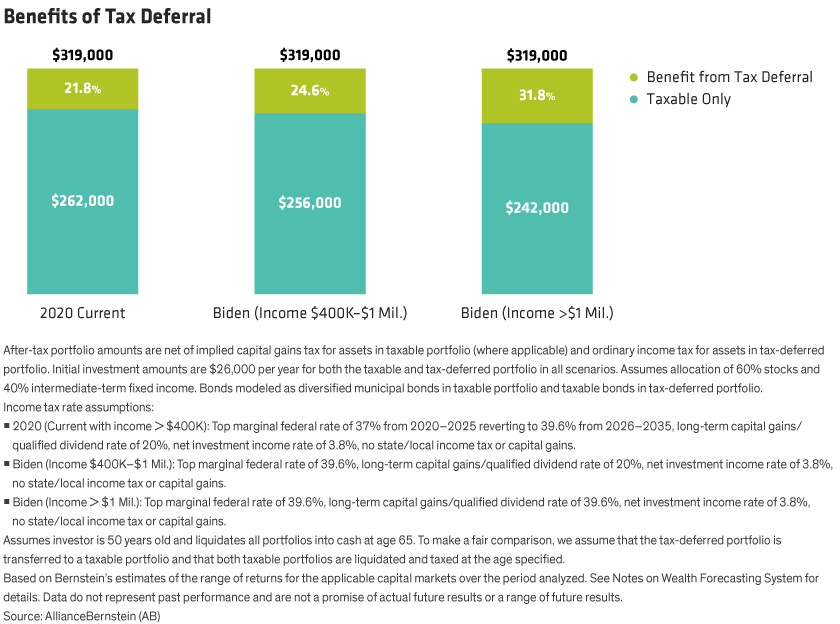Polls pointing to a potential Democratic victory have raised questions about tax reform. How might it take shape under a Biden administration—and does it still make sense to maximize tax-deferred savings?
Without question, yes. In a rising tax environment, tax-deferred plans become even more valuable. For a better understanding, let’s first look at the potential changes a new administration might bring.
What’s Changed?
The Biden tax plan—which would likely require unified control of both the White House and Congress—proposes a number of changes, several of which directly impact the value of tax-deferred savings:
- Reversion of top marginal tax rate: Rolling back the top marginal tax rate to 43.4% (from 40.8%) for investors with earned income greater than $400k per year would increase the tax burden on top-rate payers but enhance the value of tax deferral.
- Taxation of long-term capital gains for high earners: Current law allows for a favorable 23.8% tax rate on investments held longer than one year. However, in what could be the most impactful change, ordinary income rates for any earned income greater than $1M per year would apply. For those fortunate enough to enjoy sizable incomes, the additional tax could be significant, making the case for tax deferral even more compelling. This holds particularly true for those residing in states with high income taxes.
Consistent Benefits from Tax Deferral
When considering how tax deferral can benefit your personal circumstances, you must consider numerous variables, such as your tax bracket, annual income, and deductions.
For instance, consider a 50-year-old saving in a tax-deferred 401(k), with plans to access the funds in retirement at age 65. To model a baseline, we first ask how the investor would have fared under the existing tax regime. Then we compared the results against two different scenarios using the Biden tax assumptions:
I. The first considers the impact for investors earning between $400k and $1 million per year
II. The second models for those earning greater than $1 million
In our display, each column measures the incremental benefit (on an after-tax basis) of using a tax-deferred plan versus a taxable account. We found that the incremental benefit remains significant across every scenario, ranging from 22% - 32% in additional savings by utilizing a tax-deferred vehicle.

Deferral Trumps Politics
Given political realities, meaningful changes to the tax code are unlikely to pass without Democratic control of the Senate. But even if this occurs, the value of tax deferral endures—especially for those with higher earned income and those who maximize their contributions. This holds true regardless of where one lives but is even more crucial for investors receiving sizable incomes. In those cases, greater burden brings greater benefit.
The views expressed herein do not constitute, and should not be considered to be, legal or tax advice. The tax rules are complicated, and their impact on a particular individual may differ depending on the individual’s specific circumstances. Please consult with your legal or tax advisor regarding your specific situation.